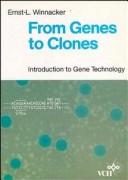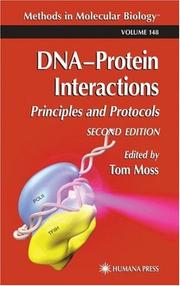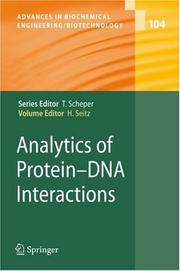| Listing 1 - 10 of 14 | << page >> |
Sort by
|

ISBN: 3527266445 0895736144 9783527266449 Year: 1987 Publisher: Weinheim : VCH Publishers,
Abstract | Keywords | Export | Availability | Bookmark
 Loading...
Loading...Choose an application
- Reference Manager
- EndNote
- RefWorks (Direct export to RefWorks)
Biological techniques --- Molecular biology --- Biotechnology --- Molecular cloning --- Recombinant DNA --- Genetic engineering --- Clonage moléculaire --- ADN recombinant --- Génie génétique --- DNA, Recombinant --- Cloning, Molecular --- methods --- 575.113.1 --- #WSCH:MONO --- methods. --- Inheritance information. Nature of gene. Genetic code --- 575.113.1 Inheritance information. Nature of gene. Genetic code --- Clonage moléculaire --- Génie génétique --- Molecular cloning. --- DNA. --- DNA --- Cloning, Molecular - methods --- Bacteria --- Eukaryotic cells --- Genetic recombination --- Mutation --- Nuclease, restriction endodeoxyribo --- -Plant --- Plant --- Plasmids --- Prokaryotic cells --- Recombination, genetic --- Yeasts
Book
ISBN: 1872748007 Year: 1991 Publisher: London : BIOS,
Abstract | Keywords | Export | Availability | Bookmark
 Loading...
Loading...Choose an application
- Reference Manager
- EndNote
- RefWorks (Direct export to RefWorks)
Molecular biology --- Biologie moléculaire --- Laboratoire --- laboratories --- Enzymes --- Bacteria --- Bacteriophages --- Plasmide --- plasmids --- Clonage --- cloning --- genomes --- genes --- Électrophorèse --- Electrophoresis --- Hybridation --- Hybridization --- Centrifugation --- Centrifuging --- Sécurité --- safety --- Méthylation --- Methylation --- ADN --- DNA --- Nucléase --- Nucleases --- Estérase --- Esterases --- GENETIC TECHNIQUES --- MICROBIOLOGICAL TECHNIQUES --- tables --- outlines --- tables. --- outlines. --- Genetic techniques --- Microbiological techniques --- Tables. --- Outlines. --- Biologie moléculaire --- Centrifuging. --- Methylation. --- DNA. --- Restriction --- Arn polymerase --- Topoisomerase --- BACTERIA --- VIRUS, BACTERIAL --- RADIOELEMENTS --- MOLECULAR CLONING --- GENES --- ENZYMES --- ELECTROPHORESIS --- CENTRIFUGATION --- SAFETY --- BIOLOGICAL STUDIES

ISBN: 0896036251 0896036715 0585403228 9786610830183 1280830182 1592592082 9780896036710 9780896036253 Year: 2001 Volume: 148 Publisher: Totowa, NJ : Humana Press : Imprint: Humana,
Abstract | Keywords | Export | Availability | Bookmark
 Loading...
Loading...Choose an application
- Reference Manager
- EndNote
- RefWorks (Direct export to RefWorks)
DNA-protein interactions are fundamental to understanding biological growth, development, differentiation, evolution, and disease, and are also increasingly important to the biotechnology industry. In DNA-Protein Interactions: Principles and Protocols, 2nd Edition, Dr. Tom Moss assembles the new standard collection of cutting-edge techniques to identify key protein-DNA interactions, define their components, and determine the nature of their interactions and their manner of function, both in the cell and in the test tube. Each detailed method has been optimized and tested by a hands-on expert to ensure experimental success, and provides helpful notes on pitfalls to avoid, as well as alternate strategies. The techniques span a wide range, from factor identification to atomic detail, and include multiple DNA footprinting analyses, including in vivo strategies, gel shift (EMSA) optimization, SELEX, surface plasmon resonance, site-specific DNA-protein crosslinking, and UV laser crosslinking. There are also vanguard methods for designing proteins to fit DNA, site-specific protein-directed DNA cleavage, and 2D semicrystalline arrays of nucleoproteins for structure determination. Comprehensive and broad ranging, DNA-Protein Interactions: Principles and Protocols, 2nd Edition, offers a stellar array of over 100 up-to-date and readily reproducible techniques that biochemists and molecular, cellular, and developmental biologists can use successfully today to illuminate DNA-protein interactions.
DNA-protein interactions --- DNA-protein interactions. --- Electronic books. -- local. --- Protein binding. --- Nuclease Protection Assays --- Proteins --- Genetic Techniques --- Amino Acids, Peptides, and Proteins --- Investigative Techniques --- Analytical, Diagnostic and Therapeutic Techniques and Equipment --- Chemicals and Drugs --- DNA Footprinting --- DNA-Binding Proteins --- Human Anatomy & Physiology --- Health & Biological Sciences --- Animal Biochemistry --- Life sciences. --- Cell biology. --- Life Sciences. --- Cell Biology. --- Cell biology --- Cellular biology --- Biology --- Cells --- Cytologists --- Biosciences --- Sciences, Life --- Science --- Cytology.

ISBN: 0123039703 0125215215 9786611714642 128171464X 0080860508 9780123039705 Year: 1990 Volume: 21 Publisher: London : Academic Press,
Abstract | Keywords | Export | Availability | Bookmark
 Loading...
Loading...Choose an application
- Reference Manager
- EndNote
- RefWorks (Direct export to RefWorks)
Genetic Engineering --- Plasmids --- Genetics, Microbial --- methods --- 579.252.5 --- 57.083 --- 57.083 Microbiological, virological, immunological methods and techniques --- Microbiological, virological, immunological methods and techniques --- 579.252.5 Extrachromosomal hereditary determinants. Episomes. Plasmide. --- Extrachromosomal hereditary determinants. Episomes. Plasmide. --- Biological techniques --- Monera --- methodology --- Microbiology --- plasmids --- Biotechnology --- ADN --- DNA --- Electrophoresis --- Microscopy --- genetic transformation --- genes --- Transcription --- transcription --- genetic engineering --- Addresses, essays, lectures --- DNA. --- transcription. --- Molecular cloning. --- Genetic Engineering - methods --- Base sequence --- Nuclease, restriction endodeoxyribo --- -Plasmids --- Vecteur de clonage --- Translation --- Hybridation de dna
Book
Year: 2022 Publisher: Basel MDPI - Multidisciplinary Digital Publishing Institute
Abstract | Keywords | Export | Availability | Bookmark
 Loading...
Loading...Choose an application
- Reference Manager
- EndNote
- RefWorks (Direct export to RefWorks)
Ornamental crops account for more than US $42 billion globally. With the exception of few floral species, limited genetic, genomic, and breeding information is publicly available, owing to the fact that the majority of breeding work is performed by the private sector. Public research programs are increasingly participating in ornamental cultivar development and genetic studies. With lower sequencing costs, genomic information of non-model species including ornamental crops is continuously becoming available. Ornamental breeding utilizes a wide array of breeding strategies ranging from traditional crossing and selection methods to the use of next-generation sequencing in genomics and transcriptomics for gene identification and trait development. A continuing search of new species for the ornamentals industry has resulted in the utilization of tools that increase diversity and in the development of alternative methods for obtaining new crops by achieving interspecific and intergeneric crosses. This Special Issue aimed to present papers on new breeding methods, novel cultivars and species entering the ornamental industry, the identification of genes conferring novel traits, technological developments in ornamentals research, and the use of next-generation sequencing to improve ornamental plants.
Technology: general issues --- Biotechnology --- Acer buergerianum --- Acer ginnala --- Acer platanoides --- Acer tataricum ssp. ginnala --- ploidy manipulation --- sterility --- Hydrangea macrophylla --- SSR --- SNP --- linkage map --- flower senescence --- nuclease --- nutrient deficiency --- petals --- programmed cell death --- virus induced gene silencing --- bolting --- cut flower --- germinal pore --- ornamental plant --- polyploidy periclinal chimera --- Plumbaginaceae --- polyploidy breeding --- cold hardiness --- LT50 --- sucrose --- oligosaccharides --- soluble sugar metabolism --- gene expression --- breeding --- geophytes --- interspecific cross --- plant hormone treatment --- pollen-pistil interaction --- pre-zygotic barrier --- Ranunculaceae --- n/a
Book
Year: 2022 Publisher: Basel MDPI - Multidisciplinary Digital Publishing Institute
Abstract | Keywords | Export | Availability | Bookmark
 Loading...
Loading...Choose an application
- Reference Manager
- EndNote
- RefWorks (Direct export to RefWorks)
Ornamental crops account for more than US $42 billion globally. With the exception of few floral species, limited genetic, genomic, and breeding information is publicly available, owing to the fact that the majority of breeding work is performed by the private sector. Public research programs are increasingly participating in ornamental cultivar development and genetic studies. With lower sequencing costs, genomic information of non-model species including ornamental crops is continuously becoming available. Ornamental breeding utilizes a wide array of breeding strategies ranging from traditional crossing and selection methods to the use of next-generation sequencing in genomics and transcriptomics for gene identification and trait development. A continuing search of new species for the ornamentals industry has resulted in the utilization of tools that increase diversity and in the development of alternative methods for obtaining new crops by achieving interspecific and intergeneric crosses. This Special Issue aimed to present papers on new breeding methods, novel cultivars and species entering the ornamental industry, the identification of genes conferring novel traits, technological developments in ornamentals research, and the use of next-generation sequencing to improve ornamental plants.
Acer buergerianum --- Acer ginnala --- Acer platanoides --- Acer tataricum ssp. ginnala --- ploidy manipulation --- sterility --- Hydrangea macrophylla --- SSR --- SNP --- linkage map --- flower senescence --- nuclease --- nutrient deficiency --- petals --- programmed cell death --- virus induced gene silencing --- bolting --- cut flower --- germinal pore --- ornamental plant --- polyploidy periclinal chimera --- Plumbaginaceae --- polyploidy breeding --- cold hardiness --- LT50 --- sucrose --- oligosaccharides --- soluble sugar metabolism --- gene expression --- breeding --- geophytes --- interspecific cross --- plant hormone treatment --- pollen-pistil interaction --- pre-zygotic barrier --- Ranunculaceae --- n/a
Book
Year: 2022 Publisher: Basel MDPI - Multidisciplinary Digital Publishing Institute
Abstract | Keywords | Export | Availability | Bookmark
 Loading...
Loading...Choose an application
- Reference Manager
- EndNote
- RefWorks (Direct export to RefWorks)
Ornamental crops account for more than US $42 billion globally. With the exception of few floral species, limited genetic, genomic, and breeding information is publicly available, owing to the fact that the majority of breeding work is performed by the private sector. Public research programs are increasingly participating in ornamental cultivar development and genetic studies. With lower sequencing costs, genomic information of non-model species including ornamental crops is continuously becoming available. Ornamental breeding utilizes a wide array of breeding strategies ranging from traditional crossing and selection methods to the use of next-generation sequencing in genomics and transcriptomics for gene identification and trait development. A continuing search of new species for the ornamentals industry has resulted in the utilization of tools that increase diversity and in the development of alternative methods for obtaining new crops by achieving interspecific and intergeneric crosses. This Special Issue aimed to present papers on new breeding methods, novel cultivars and species entering the ornamental industry, the identification of genes conferring novel traits, technological developments in ornamentals research, and the use of next-generation sequencing to improve ornamental plants.
Technology: general issues --- Biotechnology --- Acer buergerianum --- Acer ginnala --- Acer platanoides --- Acer tataricum ssp. ginnala --- ploidy manipulation --- sterility --- Hydrangea macrophylla --- SSR --- SNP --- linkage map --- flower senescence --- nuclease --- nutrient deficiency --- petals --- programmed cell death --- virus induced gene silencing --- bolting --- cut flower --- germinal pore --- ornamental plant --- polyploidy periclinal chimera --- Plumbaginaceae --- polyploidy breeding --- cold hardiness --- LT50 --- sucrose --- oligosaccharides --- soluble sugar metabolism --- gene expression --- breeding --- geophytes --- interspecific cross --- plant hormone treatment --- pollen-pistil interaction --- pre-zygotic barrier --- Ranunculaceae
Book
ISBN: 3039280759 3039280740 Year: 2020 Publisher: MDPI - Multidisciplinary Digital Publishing Institute
Abstract | Keywords | Export | Availability | Bookmark
 Loading...
Loading...Choose an application
- Reference Manager
- EndNote
- RefWorks (Direct export to RefWorks)
The deficits of mammography and the potential of noninvasive diagnostic testing using circulating miRNA profiles are presented in our first review article. Exosomes are important in the transfer of genetic information. The current knowledge on exosome-associated DNAs and on vesicle-associated DNAs and their role in pregnancy-related complications is presented in the next article. The major obstacle is the lack of a standardized technique for the isolation and measurement of exosomes. One review has summarized the latest results on cell-free nucleic acids in inflammatory bowel disease (IBD). Despite the extensive research, the etiology and exact pathogenesis are still unclear, although similarity to the cell-free ribonucleic acids (cfRNAs) observed in other autoimmune diseases seems to be relevant in IBD. Liquid biopsy is a useful tool for the differentiation of leiomyomas and sarcomas in the corpus uteri. One manuscript has collected the most important knowledge of mesenchymal uterine tumors and shows the benefits of noninvasive sampling. Microchimerism has also recently become a hot topic. It is discussed in the context of various forms of transplantation and transplantation-related advanced therapies, the available cell-free nucleic acid (cfNA) markers, and the detection platforms that have been introduced. Ovarian cancer is one of the leading serious malignancies among women, with a high incidence of mortality; the introduction of new noninvasive diagnostic markers could help in its early detection and treatment monitoring. Epigenetic regulation is very important during the development of diseases and drug resistance. Methylation changes are important signs during ovarian cancer development, and it seems that the CDH1 gene is a potential candidate for being a noninvasive biomarker in the diagnosis of ovarian cancer. Preeclampsia is a mysterious disease—despite intensive research, the exact details of its development are unknown. It seems that cell-free nucleic acids could serve as biomarkers for the early detection of this disease. Three research papers deal with the prenatal application of cfDNA. Copy number variants (CNVs) are important subjects for the study of human genome variations, as CNVs can contribute to population diversity and human genetic diseases. These are useful in NIPT as a source of population specific data. The reliability of NIPT depends on the accurate estimation of fetal fraction. Improvement in the success rate of in vitro fertilization (IVF) and embryo transfer (ET) is an important goal. The measurement of embryo-specific small noncoding RNAs in culture media could improve the efficiency of ET.
n/a --- screening --- single nucleotide polymorphism --- predictive and preventive approach --- PTEN --- cell-free DNAs --- fetal fraction --- gestational hypertension --- RASSF1 --- CDH1 --- RT-PCR --- cfDNA --- statistical models --- hematopoietic stem cell transplantation --- NanoString --- solid organ transplantation --- copy number variants --- sarcomas --- liquid biopsy --- obesity --- fetal DNA --- neutrophil extracellular traps --- mammography --- non-invasive prenatal testing --- ovarian cancer --- circulating miRNA --- pyrosequencing --- growth retardation --- preeclampsia --- gestational diabetes mellitus --- biomarker --- inflammatory bowel disease --- multi-level diagnostics --- PAX1 --- population study --- nuclease activity --- NETosis --- omics --- piRNA --- cell-free DNA --- prediction --- leiomyosarcomas --- network analysis --- NGS --- statistical methods --- circulating nucleic acids --- deletion/insertion polymorphism --- gender differences --- leiomyomas --- fetal growth restriction --- blood plasma --- exosomes --- miRNA --- pregnancy-related complications --- NIPT --- genetic marker --- cell-free nucleic acids --- extracellular vesicles --- expression --- next generation sequencing --- breast cancer --- individualized patient profile --- circulating tumor cells --- maternal serum screening --- personalized medicine --- embryo culture medium --- C19MC microRNA --- DNA --- cell-free RNAs --- z-score --- fetal cells --- microchimerism --- aging --- plasma
Book
Abstract | Keywords | Export | Availability | Bookmark
 Loading...
Loading...Choose an application
- Reference Manager
- EndNote
- RefWorks (Direct export to RefWorks)
Polypharmacy is a necessary and important aspect of drug treatment; however, it becomes a challenge when the medication risks outweigh the benefits for an individual patient. Drug–drug interactions and the introduction of prescribing cascades are common features of polypharmacy, which can lead to ineffectiveness and increased risk of adverse drug reactions (ADR). Genes encoding CYP450 isozymes and other drug-related biomarkers have attracted considerable attention as targets for pharmacogenetic (PGx) testing due to their impact on drug metabolism and response. This Special Issue is devoted to explore the status and initiatives taken to circumvent ineffectiveness and to improve medication safety for polypharmacy patients. Specific areas include drug–drug interactions and consequences thereof in therapeutic management, including PK- and PD-profiling; the application of PGx-based guidance and/or decision tools for drug–gene and drug–drug gene interactions; medication reviews; development and application of deprescribing tools; and drivers and barriers to overcome for successful implementation in the healthcare system.
Medicine --- Pharmaceutical industries --- acute kidney injury --- early biomarker --- plasma neutrophil gelatinase-associated lipocalin --- soluble urokinase plasminogen activator receptor --- medication optimization --- older patients --- emergency department --- multimorbidity --- polypharmacy --- potentially inappropriate medication use --- older adults --- prevalence --- determinants --- chronic --- outpatient --- 2019 Beers criteria --- Ethiopia --- pharmacogenomics --- persons with diabetes --- drug–drug interactions --- drug–gene interactions --- cytochrome P450 --- SLCO1B1 --- drug interaction checkers --- adverse drug reactions --- pharmacogenetics --- personalized medicine --- phenprocoumon --- DOACs --- bleeding --- thromboembolism --- HLA --- drug hypersensitivity --- abacavir --- allopurinol --- flucloxacillin --- antiepileptic drugs --- cost-effectiveness --- shared medication record --- medication reconciliation --- drug information service --- hospital pharmacy service --- electronic prescribing --- electronic medical record --- clinical pharmacist --- CYP2D6 --- CYP2D7P --- CYP2D8P --- copy number variation --- CNV --- genotyping --- 5’nuclease assay --- HRM --- high resolution melting --- drug metabolization --- extracellular vesicles --- exosomes --- microvesicles --- pharmacogene expression --- medication review --- deprescriptions --- quality of life --- aged --- aged, 80 and over --- nursing homes --- deprescribing --- medication-based risk score --- health outcomes --- cytochromes --- CYP1A2 --- adverse drug reaction --- antipsychotics --- olanzapine --- clozapine --- loxapine --- children --- youth --- digital decision-support --- health services research --- general practice --- process evaluation --- antidepressants --- utility --- population-based --- appropriateness --- medication adherence --- digital health --- acute kidney injury --- early biomarker --- plasma neutrophil gelatinase-associated lipocalin --- soluble urokinase plasminogen activator receptor --- medication optimization --- older patients --- emergency department --- multimorbidity --- polypharmacy --- potentially inappropriate medication use --- older adults --- prevalence --- determinants --- chronic --- outpatient --- 2019 Beers criteria --- Ethiopia --- pharmacogenomics --- persons with diabetes --- drug–drug interactions --- drug–gene interactions --- cytochrome P450 --- SLCO1B1 --- drug interaction checkers --- adverse drug reactions --- pharmacogenetics --- personalized medicine --- phenprocoumon --- DOACs --- bleeding --- thromboembolism --- HLA --- drug hypersensitivity --- abacavir --- allopurinol --- flucloxacillin --- antiepileptic drugs --- cost-effectiveness --- shared medication record --- medication reconciliation --- drug information service --- hospital pharmacy service --- electronic prescribing --- electronic medical record --- clinical pharmacist --- CYP2D6 --- CYP2D7P --- CYP2D8P --- copy number variation --- CNV --- genotyping --- 5’nuclease assay --- HRM --- high resolution melting --- drug metabolization --- extracellular vesicles --- exosomes --- microvesicles --- pharmacogene expression --- medication review --- deprescriptions --- quality of life --- aged --- aged, 80 and over --- nursing homes --- deprescribing --- medication-based risk score --- health outcomes --- cytochromes --- CYP1A2 --- adverse drug reaction --- antipsychotics --- olanzapine --- clozapine --- loxapine --- children --- youth --- digital decision-support --- health services research --- general practice --- process evaluation --- antidepressants --- utility --- population-based --- appropriateness --- medication adherence --- digital health

ISSN: 07246145 ISBN: 9783540481478 3540481478 3540481508 9786610727575 1280727578 Year: 2007 Volume: 104 Publisher: Berlin, Heidelberg : Springer,
Abstract | Keywords | Export | Availability | Bookmark
 Loading...
Loading...Choose an application
- Reference Manager
- EndNote
- RefWorks (Direct export to RefWorks)
DNA-protein interactions --- DNA-Binding Proteins --- DNA Footprinting --- genetics --- methods --- chemistry --- Biochemistry --- Biotechnology --- Human genetics --- Medicine --- Microbiology --- Interactions ADN-protéine --- Biology. --- DNA-protein interactions. --- Electronic books. -- local. --- Proteins --- Nuclease Protection Assays --- Genetic Techniques --- Investigative Techniques --- Amino Acids, Peptides, and Proteins --- Chemicals and Drugs --- Analytical, Diagnostic and Therapeutic Techniques and Equipment --- Human Anatomy & Physiology --- Health & Biological Sciences --- Mechanical Engineering --- Engineering & Applied Sciences --- Animal Biochemistry --- Bioengineering --- Biomedical Engineering --- DNA-protein binding --- Interactions, DNA-protein --- Protein-DNA interactions --- Chemistry. --- Medical microbiology. --- Analytical chemistry. --- Biotechnology. --- Genetic engineering. --- Medicinal chemistry. --- Biochemistry. --- Genetic Engineering. --- Biochemistry, general. --- Analytical Chemistry. --- Medical Microbiology. --- Medicinal Chemistry. --- Biological chemistry --- Chemical composition of organisms --- Organisms --- Physiological chemistry --- Biology --- Chemistry --- Medical sciences --- Chemistry, Medical and pharmaceutical --- Chemistry, Pharmaceutical --- Drug chemistry --- Drugs --- Medical chemistry --- Medicinal chemistry --- Pharmacochemistry --- Designed genetic change --- Engineering, Genetic --- Gene splicing --- Genetic intervention --- Genetic surgery --- Genetic recombination --- Transgenic organisms --- Chemical engineering --- Genetic engineering --- Analysis, Chemical --- Analytical chemistry --- Chemical analysis --- Metallurgical analysis --- Mineralogy, Determinative --- Physical sciences --- Composition --- Life sciences --- Biomass --- Life (Biology) --- Natural history --- DNA-ligand interactions --- Protein binding --- Analytical biochemistry. --- Microbiology. --- Microbial biology --- Microorganisms --- Analytic biochemistry --- Chemistry, Analytic --- Bioanalytic chemistry --- Bioanalytical chemistry --- Analytic chemistry
| Listing 1 - 10 of 14 | << page >> |
Sort by
|

 Search
Search Feedback
Feedback About UniCat
About UniCat  Help
Help News
News